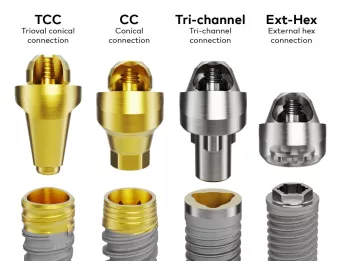Technical Support - Frequently Asked Questions (FAQs)
Prosthetic support
What is the torque value for … (prosthetic)?
The torque values for prosthetic components can be found in the Prosthetic Component Torque Guide.
What is the difference between a replica and an analog?
An analog is a term often used in the implant industry to represent one component being substituted for another.
Within Nobel Biocare, the substitution for the implants used in dental laboratory models is referred to as an implant replica. Likewise, the component used in the dental laboratory model as substitute for a Multi-unit Abutment is called an “Abutment Replica Multi-unit”.
Nobel Biocare also produces analogs, which are used for protection of the seating interface of either single unit abutments or multiple unit frameworks using Multi-unit Abutments.
For single unit abutments, or one piece temporary crowns processed to either a Temporary Abutment Plastic or Titanium, to protect the interface “Protection Analogs” representing the implant platform can be used. They are typically used with the “Handle for Protection Analogs” to make trimming and polishing of the restoration easier.
For multiple unit restorations using a framework made to Multi-unit Abutments the products are referred to as “Protection Analog Multi-unit”.
Are the Impression Copings Closed Tray Plastic radio-opaque?
Yes, the Impression Copings Closed Tray Plastic are radio-opaque.
Does Nobel Biocare offer all-plastic UCLA abutments?
No, because of the loss of precision with burn-out patterns and casting, the Nobel Biocare GoldAdapt has a precision gold alloy base machined to specifications for precise fit at the implant/abutment interface. There is a wax-pattern for the screw-access hole and any design of abutment may be waxed and cast to the GoldAdapt Abutment.
What material are the Multi-Unit Abutment replicas made of?
Multi-unit Abutment replicas are made of stainless steel.
What is the degree of taper of the Snappy Abutments?
Snappy Abutments have a 3-degree taper.
How can I tell which connection type an implant uses?
Please see the following images to help you identify the various current Nobel Biocare implant connection types:
Connection types

What do the color codes on your components represent?
The implant seating surface where the abutment or restoration seats is referred to as a platform. Besides the four different connection interfaces shown above, there are diameter variations for these different connections. The color coding on implants and abutment components, as well as some packaging, is to identify compatibility between implants and abutments within the same connection type.
There is also a blue color coding used on abutment screws for the Angulated Screw Channel that are unique and only compatible with this component.
How do I choose the correct impression coping?
There are impression copings for Multi-unit Abutments and for all implants. For the Multi-unit Abutments and implant level impression copings, there are choices of either closed tray or open tray impression copings.
For many clinical situations, either style of impression coping may be used. However, there are certain instances where one approach is indicated over the other:
Closed tray impression copings are recommended in patients with less mouth opening, in limited access areas and with patients with a highly-sensitive gagging reflex.
Open tray impression copings are recommended in cases with multiple implants, and must be used in cases with multiple implants that diverge more than 25°.
Once this is decided, the impression copings are chosen by
- connection type (see above)
- platform diameter
- if applicable, healing abutment diameter. Matching the diameter of the impression coping to the diameter of the healing abutment helps capture soft tissue information for transference to the laboratory model.
Surgical support
Can I sterilize and reuse my drills?
Nobel Biocare tapered drills, dense bone drills, and screw taps for tapered implants are reusable and should be replaced after 20-30 uses, or when cutting efficiency declines. Worn-out and damaged drills should be discarded and replaced with new sharp drills. Please follow the cleaning and sterilization techniques shown here.
Twist and Twist Step Drills, Precision Drills, and Counterbores are delivered sterile and should be discarded after use.
What if my drill unit stops working?
For technical support and repair of KaVo EXPERTsurg™ and MASTERsurg™, please follow the instructions on the following website.
For technical support and repair of the OsseoSet 300, please locate your closest service partner on the following website.
If I drop an implant, can I return it for credit?
The Implant Replacement Service (IRS) allows the clinician to exchange dropped implants or implants that spent less than 24 hours in a patient's mouth for the same type of implant. You can exchange up to ten dropped implants per year.
Please contact your local sales representative for assistance.
What are the torque values for . . . (implants)?
Unlike abutment screws or Multi-unit prosthetic screws that have a precise fastening torque specified, for implants only a maximum insertion torque is specified. Any final insertion torque that falls below this maximum may be clinically acceptable but also may influence decisions for immediate or early loading based on those additional requirements.
Please reference the Implant Torque Guide for additional information.
Software support
Where can I find the latest version of DTX Studio™ Implant Software?
Please contact your local sales representative for assistance.
Where can I find the latest version of NobelProcera Software?
Please contact your local sales representative for assistance.
How do I get help with my NobelProcera Scanner?
For help with NobelProcera Software and Scanners, please contact technical support at +36 20 479 7567.
Where can I get training on DTX Studio™ Implant Software?
Please visit our training website for tutorials on specific tasks within the DTX Studio™ Implant software.